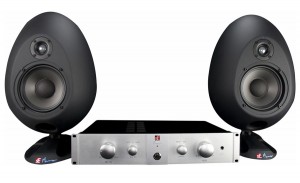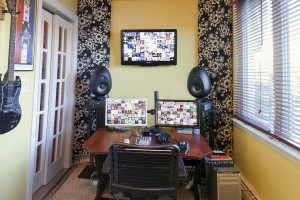Review: sE Munro Egg 150 Monitors by Zach McNees
Studio monitors are arguably the most crucial element of any recording studio setup. Day after day, year after year, the speakers that we judge our work on are one of the few pieces of gear in the studio that can bring a session to a grinding halt if they’re not working up to par.
So it stands to reason that studio monitor brands breed fiercely loyal customers. There are a select few companies that most engineers can agree will always translate their work accurately wherever they go. And a new brand has to really be something special to make that cut.
When sE Electronics – a UK-based company with a sterling reputation for their hand-crafted line of microphones – announced they’d partnered with acoustic consultant/studio designer Andy Munro to design a pair of studio monitors from the ground up, many in the audio world took notice. These monitors could be that something special.
The result of their collaboration is the sE Munro Egg 150 monitoring system. Let’s take a look at what this unique system has to offer.
TECH SPECS: The Egg 150 system is what sE Electronics deems an ‘active integrated monitoring system’. The system is comprised of a stereo control unit power amp, which powers a pair of two-way egg-shaped speakers. The system retails for $2,499 USD.
THE SYSTEM: The core of the system is a stereo two-way active power amp featuring four 50WRMS power amplifiers with dual linear power supplies housed in a single control unit.
The design face is sleek and clean featuring large Main and Aux volume knobs. Additional controls enable switching between Aux and Main sources as well as a unique mid frequency equalization with ‘Hard, Soft or Reference (0)’ controls. This feature is designed to subtly replicate a slightly more “scooped” sound or a more vocal present/mid-range sound à la Yamaha NS-10s.
The control unit also features a two-way asymmetrical crossover and connects via ten foot matched Speakon cables to the two-way speakers, which feature a 1-inch HF driver and 6.4 inch LF driver.
The speakers themselves are an egg-shaped monocoque shell construction. The egg shape should make perfect sense to anyone who’s ever noticed that well designed recording studios never have parallel walls. The egg is a naturally resonant-neutral shape, which allows the speaker to project an extremely accurate representation of the source material.
One unique feature of the Egg system is the built-in LED indicator “guide beams” that are positioned directly above the tweeters on each speaker. The LED’s are used specifically when installing the system and can be shut off after installation from a switch on the back of the control unit amp. The LEDs are designed to be blindingly bright only when the user is exactly in the sweet spot between the two speakers. This allows for quick and precise setup of your Egg system.
IN USE: When the Egg system arrived at my house I was in the middle of a mixing project. Usually I try not to swap out any crucial piece of gear in the middle of a project, but in this case I decided to take a chance and swap in the Egg system. The Speakon cable connection from the amp to the speakers is an impressive feature that immediately made me feel confident in the quality and power of the system. The LED guide beams were a huge help in providing instant feedback for finding the exact spot that suited my listening position.
The results were truly remarkable right out of the box. Everything I tried from hard rock to jazz to classical and opera with a huge dynamic range all came through with striking clarity. I spent about 15 minutes listening critically to different pieces of reference material that I’m familiar with. Then, I went right back to work on my mixes. I’ve been using the Eggs ever since.
The sE Eggs are the first monitors I’ve ever used consistently that make me feel truly comfortable knowing that the mix I hear in my room will translate perfectly onto any other system.
The Egg system performs in a class way beyond its physical stature or price point. Intricate pieces of music like Sting’s “Englishman in New York” come through sounding incredibly detailed and sharp. The low-end response is phenomenal and crystal clear. It was difficult to believe that I didn’t have a sub under my desk.
With the Eggs, I don’t have to work nearly as hard to find the right spot for bass tracks to sit in my mixes. And most impressively, the Eggs are able to achieve great clarity, sharpness and depth without any of the harsh qualities that often lead to frequent ear fatigue from other pro speaker systems.
In terms of sheer power and volume, the Eggs also exceeded my original expectations. With four 50WRMS amps under the hood, there’s been power to spare in every listening test I’ve encountered thus far.
TO BE CRITICAL: My only criticism of the Egg 150 system is that the control unit does pop the speakers (the woofers most noticeably) when it’s turned off. This is quite disconcerting the first few times it happens. The folks at sE have assured me that the “pop” is the sound of the capacitors inside discharging the DC they’ve built up and is both harmless and unavoidable given the scope of the design.
IN CONCLUSION: sE has hit a home run with the Egg 150 monitoring system. The Eggs perform at or above a quality level normally reserved for powered speaker systems that cost roughly twice as much. I have strongly recommended this system to a number of engineer and studio friends and will continue to do so.
One note on customer service: The folks at sE Electronics and their U.S. distributor Fingerprint Audio have been absolutely outstanding with their communication and willingness to sort out any issues and questions I’ve had with regard to setup and installation. It’s worth mentioning as well that sE offers an aggressive demoing program allowing users to test-drive the Egg 150 system in their own studio before making a commitment to purchase. Those in the NYC area can check out the eggs in person at Alto Music, Audio Power Tools, or Dale Pro Audio.
Zach McNees is a Brooklyn-based producer/engineer/mixer and live recordist who’s worked with Björk, Rob Thomas, Julia Nunes, The Gregory Brothers, Pixies, Liars and Alice Cooper. Get in touch with Zach via http://www.zachmcnees.com.









charlie
September 28, 2012 at 12:24 am (12 years ago)Hey Z,
You have here another excellent review! One question – did you find the 10′ speaker cable length limiting in your setup? I would want to rack the control unit on one side of the mix position. This could make the far speaker farther than 10′ away from the back of the rack, across the floor then up the speaker stand. Just curious if that was a problem for you, or you could see that as a potential issue. I wonder if you could add a NL4 (or 8?) Speakon jumper to extend it out.
Zach
September 28, 2012 at 4:50 pm (12 years ago)Thanks! For me the Speakon cable length isn’t an issue as I’m in a relatively small space. I can’t speak to whether an extender would work, I would definitely recommend talking to Chris at Fingerprint Audio about possibilities. If you do end up finding a solution for longer Speakon cables I would certainly recommend both being the same length for cohesive purposes. These monitors really do kick ass. Get a demo!
Daniel
September 28, 2012 at 3:25 am (12 years ago)Thanks for the recommendation. Just bought the JBL LSR 4328P and love them. Could you give me some kind of comparison?
Zach
September 28, 2012 at 4:50 pm (12 years ago)Daniel, I haven’t heard the JBL’s you mentioned so I’m afraid I couldn’t give an accurate comparison.
Cole
October 6, 2012 at 12:13 am (12 years ago)thank you SO much for clarifying the popping. I hear it too every time I shut them off, and I thought I was going crazy and was also worried. Knowing that it’s supposed to happen makes me feel better. Thanks.
Zach McNees
November 23, 2012 at 11:38 pm (12 years ago)It’s weird I know! I did notice that plugging headphones into the control unit does break the circuit to the speakers so this would be an obvious way to avoid the popping as Moz mentioned above.
Moz
November 20, 2012 at 7:26 pm (12 years ago)Turn volume down, put a 6.5mm stereo jack adapter (or the headphones) on phones out and the pop on the speakers goes off.
Zach McNees
November 23, 2012 at 11:37 pm (12 years ago)Moz, I’ll try that! Thanks for the tip!